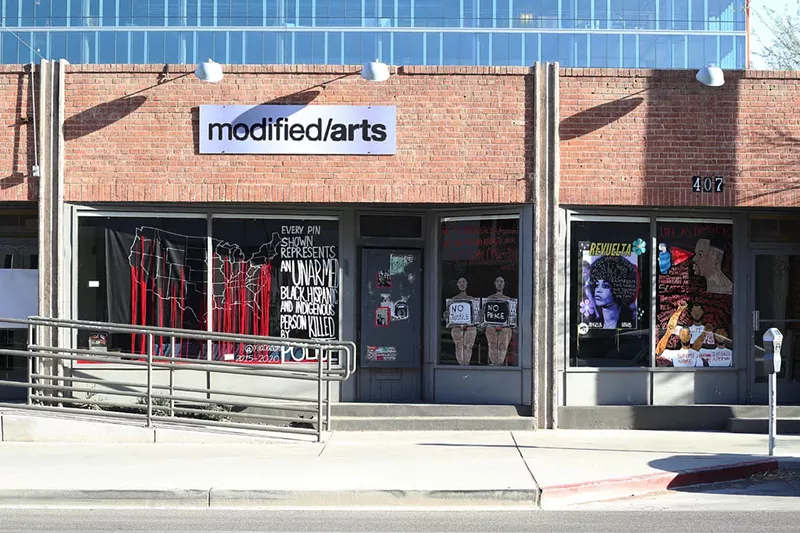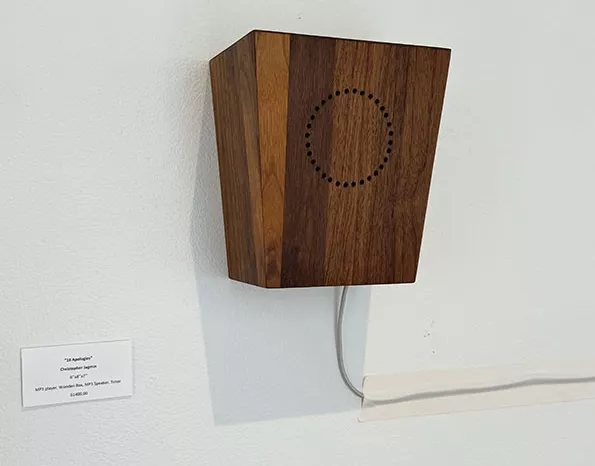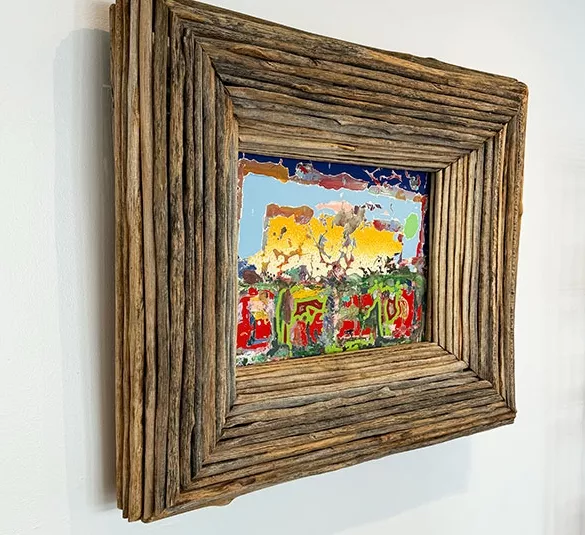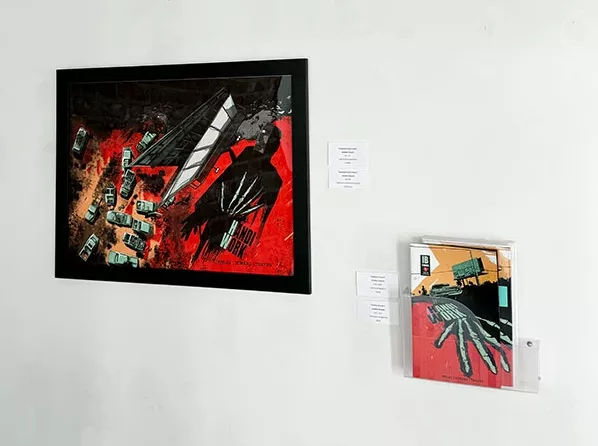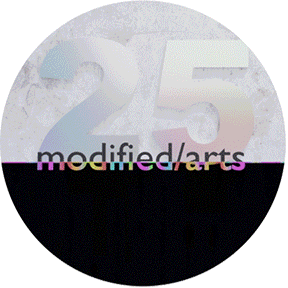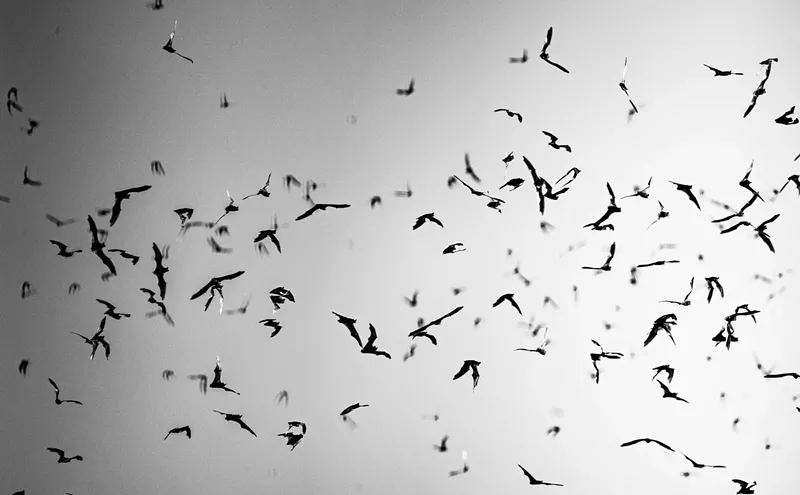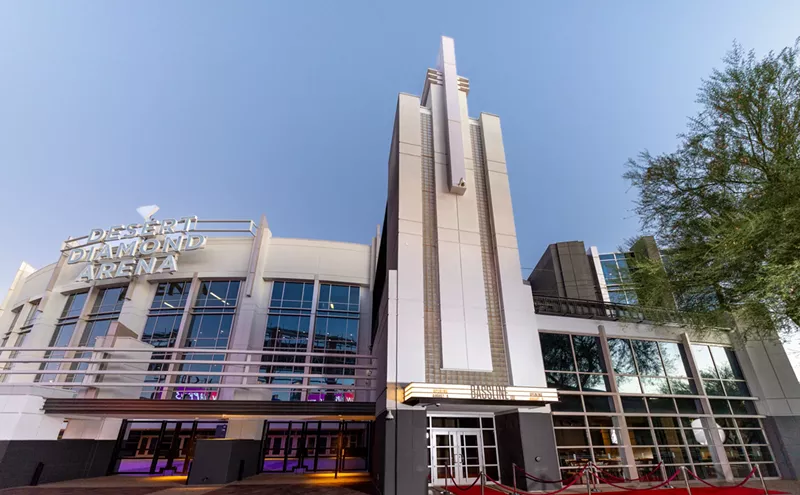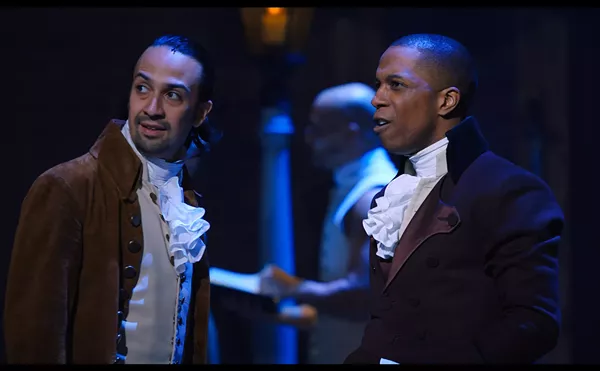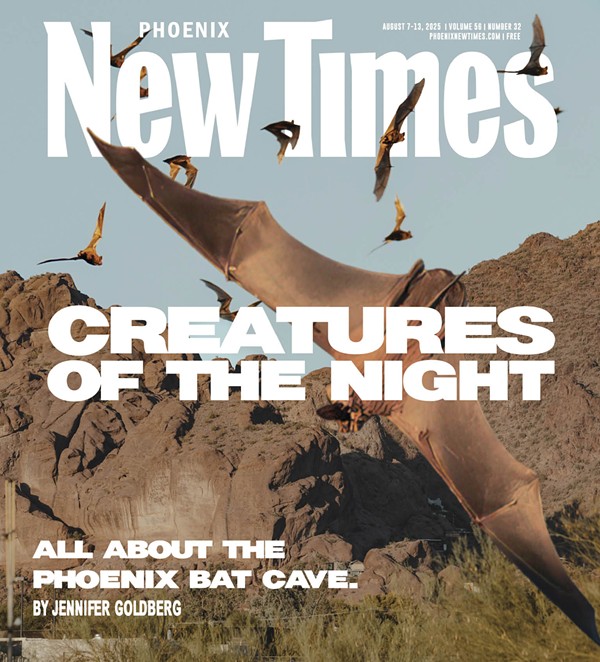This year marks the 25th anniversary of Modified Arts. The music venue/occasional gallery turned full-on gallery and performance space has helped define the artistic scene across Phoenix across a couple of generations.
The space is celebrating some of those accomplishments with a group invitational show that runs through April 12 in which 25 artists have returned to Modified to showcase their medium-spanning art. But it's a show not just to celebrate the past but to reaffirm what makes Modified such a deeply important institution in Phoenix's cultural landscape.
"I feel proud that I was able to contribute to the community," says founder Kimber Lanning. "I think at the end of the day, what's most important to me is to create a safe and inclusive environment that enables people to be their best."
That attitude of openness and exploration is fundamental to Modified's place in the city and its larger cultural and economic development. James Angel, who curated the 25th-anniversary show, remembers what it was like before Modified opened its doors way back in 1999.
"I grew up here; I can remember when the thing to do was to cruise Central (Avenue) in your car," he says. "And, you know, it's neat that there's been this epicenter of creative energy from this one location for 25 years. But having access to this creative platform over the years, I've been fortunate to witness the transformative power of arts on individuals and the downtown community as a whole."
Other collaborators/contributors have similar memories — albeit ones that also speak to the Wild West-ian flair of those early days on Roosevelt Row.
"I think about seeing a band there, and I have no idea what the band is, I can't remember at all," says local artist Brian Boner. "It was some kind of punk band. You left there incredibly tired and sweaty, but then you would walk out the door and across the street, and before all those shops were a few old historic homes and a bunch of dirt lots. I remember seeing fire breathers across the street."
He adds, "It's nice to remember how things were when it was simpler. And I don't want to say it was easier, because it wasn't. But it was more raw, and you just had this feeling of possibility."
Given that almost "anything goes" mentality, some artists remember Modified as a place to explore and develop personally and professionally in a way aligned to "old" Phoenix.
"Over the years, it has been a great learning experience," says artist/photographer Bill Timmerman. "We've actually gone in several times and added a couple of walls and modified things a little bit. We just love showing there. What we really like about it is it's just a gritty gallery. It reminds us of old L.A., when artists had no money, and those artists are now famous and wealthy. Modified is that gallery here in Phoenix."
Textile artist Ann Morton (who is also married to Timmerman) had a very specific memory about showing at Modified as a still-developing artist. It's an imperfect space that regularly demanded a little creativity and commitment outside of the actual work being done.
"One day, I had to have the show (pulled) down but I then had to put it back up by 4:30 p.m. that day because I had a collector coming to see the show," she recounts. "So I put the whole show in the back of my truck. I was doing my master's degree at the time, and I went to ASU and parked a bit illegally. My whole car with all this inside got towed. So I had to go quickly and get my truck out of the tow yard, race back downtown and then I had half an hour before the collector was going to come."
Even without such "extreme" instances, Modified is still a hugely important place for people to develop their artistic careers. To a lesser extent, it's been about forging essential relationships.
One of the more important elements of Modified, though, is that it's been a proving ground of sorts for several artists before moving onto other opportunities.
"I was a graduate student at ASU," says artist Travis Ivey. "Something started happening — more people noticed my work. I think later that year I got into Chaos Theory, which was a really good opportunity for me. I really didn't even realize when I had the first show there that it was opening opportunities. It's not a Bentley Gallery or anything, but Modified is really good for getting people noticed and getting people involved in the Phoenix art scene."
That last part's worth revisiting a bit. No, Modified isn't like the other high-end galleries in the Valley. Rather, Lanning has often leaned into Modified's "punk rock" origins to present a viable option.
"I really cut my teeth on different community ideas," Lanning says. "One of the things that I tried out is encouraging anybody that didn't have the money to come and see a show — even though we kept the shows cheap at, say, $5 or $10 — we had little coupons that we created. And if you came and volunteered on one night, you'd get a laminated card to bring to any other show in the future that you wanted to come and see for free."
She adds, "One thing is you're eliminating the barrier of entry. You're eliminating any shame that they come with 'I don't have the money.' And, most importantly, you're building community and reminding every single person that what they have to contribute matters. And we don't see enough of that."
It's an idea you can see reflected in the anniversary show's lineup.
"It's just the sheer range of the show," Angel says. "Like, there's Jeff Falk, who's one of the longest exhibiting artists that we have in the downtown arts scene, to Miguel Monzón, who's finishing his thesis right now at ASU. Artists aren't trying to fit into a gallery's box."
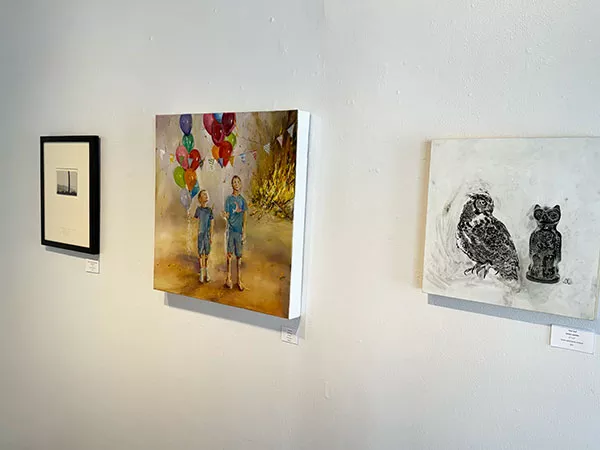
Perhaps part of that success comes from the idea that Modified doesn't curate the kind of art it wants to display. Christopher Jagmin, who was also a member of Modified's "sister gallery," eye lounge, for several years, says his shows circa 2022 helped at a time of change and transition in the arts scene.
"We were supposed to have a gallery opening in March 2020, and of course, it shut down," Jagmin says. "We were actually bringing our artwork over (to eye lounge) to install that day when we got the call. Anyway, it was a really great show for me. It was a turning point for my work. The gallery was really open to doing whatever we did. I mean, we had a little bit of controversial work and they didn't seem to mind; they just wanted to be a part of our careers and they trusted us and we trusted them. So that was a really great feeling to have a gallery like that. There are so few of them around anymore."
It's not just about letting controversy shine, either. Modified is almost genre- or style-avoidant, and it's about something altogether more powerful when you let artists speak their own truths.
"I believe that all types of art should be thought-provoking," Lanning says. "We should be an integral piece of community dialogue in every way. And so how that looks takes a lot of different states. But I would say it was curated with an eye for people who are really thriving to push themselves forward."
Angel echoed similar sentiments.
"I think that's another magical element — just the way that it flows," he says. "The artists are really empowered to be just as creative as they want to be. There aren't necessarily a lot of restrictions or parameters. You throw down at Modified. I think that it's just about empowerment. Or creative license."
As did Boner — it’s about a distinct lack of control.
"But I think the beauty of it is that it's always allowed the artist to be the artist," he says. "And not try to control anybody to anything. Kimber's always been very welcoming and supportive of all kinds of art, whether it be music or dance or painting."
Still, it's not just about the mediums; the messaging of the artists at Modified (and certainly the 25th anniversary show) are just as robust and compelling. For instance, Boner said that his paintings of his two young sons "addresses the challenges and the perils for future generations." Meanwhile, Ilvey, who also paints abstract pieces, does plenty of "Western landscapes, sometimes dealing with issues about the environment and industrial, extractive industries and trying to draw attention to that landscape."
For Jagmin, Modified is a place for some similarly personal stories, albeit with a slight twist.
"I tell personal stories, but I also tell stories about anxiety, especially in these times," he says. "I use words to literally tell those stories. But I don't show the same work at another gallery. For instance, I’ve done audio work before. It's really interesting that I just felt freer to show it, as opposed to a gallery that knows me from something."
Meanwhile, Morton sees Modified as a kind of artistic staging ground for much larger endeavors and expression.
"I'm what you would call a fiber textile-based artist. I use traditional textile techniques, sometimes in traditional ways," she says. "A big part of my practice is organizing large groups of people to make small pieces of work that come together in a larger whole. So I orchestrated the Violet Protest. The kind of work that I do, especially at the time when I started showing at Modified, it just wasn't the kind of work that people would put out as fine art. That first show at Modified ... I think really allowed me to show people how I could take these techniques and use them in a fine art aesthetic. So Modified really allowed that to happen."
Ivey seconded that sentiment, and explained that Modified is a place for artists to grow in important and noticeable ways.
"It's like a place where you want to try something out on the public. You might have the freedom to do that," he says. "Like, I've shown three completely different pieces over the last nine or 10 years; total experiments in a sense. So that's what I like about Phoenix, too, is that I don't have the pressure to do something for a gallery. I can do something just for the freedom and to experiment."
Still, there's at least one important aspect that sets Modified apart: It's never been about commerce.
"There's more galleries that make money," Jagmin says. "I mean, they have a reason for showing what they show. They need to have money. Modified doesn't for some strange reason. Kimber funds it, basically."
All of this sheer creative/artistic freedom doesn't mean that Modified isn't somehow being "driven" — openness doesn't equal direction-less.
"I never felt like it was a half-assed gallery," Ivey says. "It's always very well curated by people that I respect their opinions."
Adds Jagmin, "I'm really anti-show that just says, 'Heat, that's the theme.' There's no real theme; it's just this thing that's easy for gallerists to put together and not have to keep it really open. Whereas I think Modified and eye lounge really get specific about what they want to show and they have a point of view and that's important."
That aspect comes from the work of curators. Modified has had several such "leaders" over the years, and Lanning herself says that much of the space's success comes from these talented people working behind the scenes.
"I think the thing that's important to note is that I stopped curating the gallery myself after 13 years," she explains. "That was really because I felt like I myself had, after doing one show a month for 13 straight years, I wasn't able to give it the time and energy that it needed to really do the research and seek out and find and bring in new artists. And so if I wasn't really driving it forward, I thought, 'Well, let's open it up and create a space to build new curatorial talent.' We've had a total of seven curators over the last 12 years. And they've each contributed in their own ways, I think, to their vision of what is important to be said at that time."
These talents aren't just about supporting and empowering artists — the role also serves as a great proving ground for young/untapped talent.
"There's a good opportunity for people who are curating who maybe don't have a lot of experience, or they don't curate shows often," Ivey says. "They get the opportunity to put together shows at this venue that maybe they wouldn't normally have the opportunity to do. I think that's really nice to give those opportunities to people."
In turn, those same curators have gone on to have great career opportunities while also furthering the Modified spirit.
"I know that some of the curators that have been there have moved on to other places, but they really made my work better," said Jagmin. "(Merryn Alaka) was an artist who's now in Chicago at school, but she was amazing and she really wanted us to push things in a way that I wanted to but I didn't know how to. (Miguel A. Monzón) is an artist at grad school right now at ASU to finish up his studies."
He adds, "Those people were important to Modified, and they made it vibrant and made it more interesting instead of just some galleries that go, 'Let's just put the show together and just call it a day' and they're not really thinking about how it's put together or how things work and have a conversation with each other's work."
Modified is very much about the opportunities for advancement and the future at-large — not only for individual artists, but for Roosevelt and the larger local arts scene.
"Modified is an anchor on Roosevelt," Boner says. "It's something that hasn't changed or hasn't really conformed to everything else. When Modified started, there were a lot of other artist-run galleries and collectives and Modified is still there."
Given how the scene has changed in recent years, Modified's role and station remains as vital as ever.
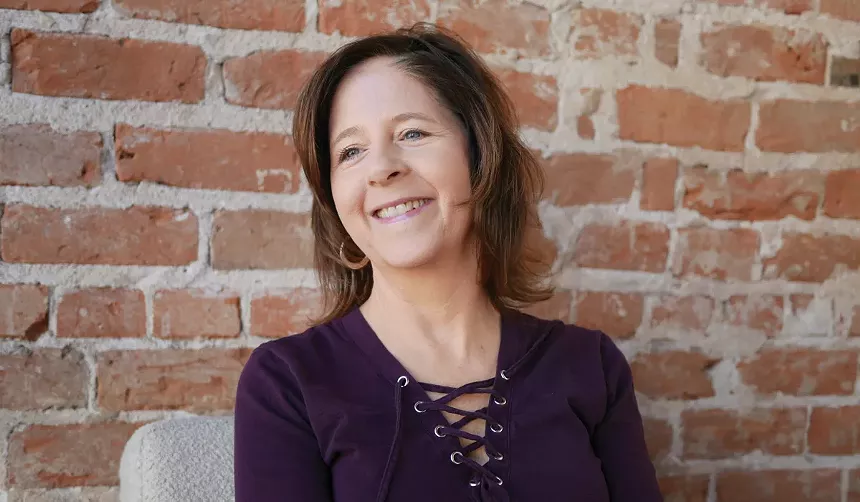
"Kimber started with Stinkweeds and then Modified, and she has evolved both of those venues into something new and present," Boner says. "On Roosevelt, things are a lot more homogenous. It's people doing a lot of the same things that other bohemian artists were doing 25 years ago. Modified is still the only one of those places — again with the exception of a few others — that really has that same sense of the ‘artist is first and not the building or the facade.’"
As such, Angel takes his work with the 25th anniversary show rather seriously.
"It's supporting that enduring spirit that brought all of the excitement to Roosevelt Row," Angel says. "And it's a call to support your creative community and the power that they wield ... that transformative power. My whole approach is reasserting the value of creative collaboration and for the recognition that the creative community deserves for the revitalization or just the impact that it's made to the development of downtown."
Of course, there's no denying that as important as it is, Modified hasn't still been affected by a struggling, somewhat diminished art scene. You can see it in a few key changes.
"I don't know if anyone has talked to you about that, but it used to be that whole back area where there's now offices," Timmerman says. "Then, for a while they'd have desks in there, but then they'd push the desks over to the side, and you'd still have most of the space, and now it's really shrunken down into that west room in the front part of the building."
Timmerman adds, "We understand it. Kimber owns the building, and she needs to use it for Local First Arizona. It's not just Modified, but eye lounge has (also) shrunk down to a very small space. So the venues that are the Phoenix arts scene, the street scene … they're few and far between now. I think Kimber's dedicated to keeping at least some space open and Modified so that we don't lose that venue."
Modified is doing its part, but so too are the artists connected to the venue. Boner recounts a recent story that speaks volumes about this very dynamic.
"There was a show recently (by Antoinette Cauley) — the whole vibe is what's going on in Phoenix," Boner says. "And so I just happened to be giving a tour of murals with my son's sixth-grade school class, and Antoinette was down (setting up). She actually encouraged us to come in, see the work and she gave us really a prompt to talk about all of her work and asked the kids to have questions. It's just that feeling that Modified encourages."
If nothing else, artists help facilitate this importance not just by showcasing their art, but by making Modified a regular destination for cultural appreciation.
"I think it's a place that artists will go to every month and check out a new artist or artists that they know very well, and it is a great gathering space," Jagmin says. "I mean, the place is funky. It's an odd space. But you use that odd space quality to make interesting things. Instead of just a white-walled kind of box gallery, you have some funkiness that causes problems, of course, for artists, but it also makes unique opportunities. It's a place where artists feel welcome."
For her part, Lanning recognizes the changes to both Modified and the surrounding arts scene. She remains dedicated not only to what's happening right now, but how all the changes — good, bad and otherwise — will continue to make Modified the institution it has been for a quarter of a century.
"So I don't foresee huge changes. It still continues on," Lanning says. "Right now, James (Angel) curated this show, and I'm curating the next one or two, and we'll see where we go from there. I think it plays a critical role there right in the middle of Roosevelt. The amount of exposure to people all day long is really unbelievable. People who haven't experienced the arts before now live in the neighborhood."
The space is celebrating some of those accomplishments with a group invitational show that runs through April 12 in which 25 artists have returned to Modified to showcase their medium-spanning art. But it's a show not just to celebrate the past but to reaffirm what makes Modified such a deeply important institution in Phoenix's cultural landscape.
"I feel proud that I was able to contribute to the community," says founder Kimber Lanning. "I think at the end of the day, what's most important to me is to create a safe and inclusive environment that enables people to be their best."
That attitude of openness and exploration is fundamental to Modified's place in the city and its larger cultural and economic development. James Angel, who curated the 25th-anniversary show, remembers what it was like before Modified opened its doors way back in 1999.
"I grew up here; I can remember when the thing to do was to cruise Central (Avenue) in your car," he says. "And, you know, it's neat that there's been this epicenter of creative energy from this one location for 25 years. But having access to this creative platform over the years, I've been fortunate to witness the transformative power of arts on individuals and the downtown community as a whole."
Other collaborators/contributors have similar memories — albeit ones that also speak to the Wild West-ian flair of those early days on Roosevelt Row.
"I think about seeing a band there, and I have no idea what the band is, I can't remember at all," says local artist Brian Boner. "It was some kind of punk band. You left there incredibly tired and sweaty, but then you would walk out the door and across the street, and before all those shops were a few old historic homes and a bunch of dirt lots. I remember seeing fire breathers across the street."
He adds, "It's nice to remember how things were when it was simpler. And I don't want to say it was easier, because it wasn't. But it was more raw, and you just had this feeling of possibility."
Given that almost "anything goes" mentality, some artists remember Modified as a place to explore and develop personally and professionally in a way aligned to "old" Phoenix.
"Over the years, it has been a great learning experience," says artist/photographer Bill Timmerman. "We've actually gone in several times and added a couple of walls and modified things a little bit. We just love showing there. What we really like about it is it's just a gritty gallery. It reminds us of old L.A., when artists had no money, and those artists are now famous and wealthy. Modified is that gallery here in Phoenix."
Textile artist Ann Morton (who is also married to Timmerman) had a very specific memory about showing at Modified as a still-developing artist. It's an imperfect space that regularly demanded a little creativity and commitment outside of the actual work being done.
"One day, I had to have the show (pulled) down but I then had to put it back up by 4:30 p.m. that day because I had a collector coming to see the show," she recounts. "So I put the whole show in the back of my truck. I was doing my master's degree at the time, and I went to ASU and parked a bit illegally. My whole car with all this inside got towed. So I had to go quickly and get my truck out of the tow yard, race back downtown and then I had half an hour before the collector was going to come."
Even without such "extreme" instances, Modified is still a hugely important place for people to develop their artistic careers. To a lesser extent, it's been about forging essential relationships.
One of the more important elements of Modified, though, is that it's been a proving ground of sorts for several artists before moving onto other opportunities.
"I was a graduate student at ASU," says artist Travis Ivey. "Something started happening — more people noticed my work. I think later that year I got into Chaos Theory, which was a really good opportunity for me. I really didn't even realize when I had the first show there that it was opening opportunities. It's not a Bentley Gallery or anything, but Modified is really good for getting people noticed and getting people involved in the Phoenix art scene."
That last part's worth revisiting a bit. No, Modified isn't like the other high-end galleries in the Valley. Rather, Lanning has often leaned into Modified's "punk rock" origins to present a viable option.
"I really cut my teeth on different community ideas," Lanning says. "One of the things that I tried out is encouraging anybody that didn't have the money to come and see a show — even though we kept the shows cheap at, say, $5 or $10 — we had little coupons that we created. And if you came and volunteered on one night, you'd get a laminated card to bring to any other show in the future that you wanted to come and see for free."
She adds, "One thing is you're eliminating the barrier of entry. You're eliminating any shame that they come with 'I don't have the money.' And, most importantly, you're building community and reminding every single person that what they have to contribute matters. And we don't see enough of that."
It's an idea you can see reflected in the anniversary show's lineup.
"It's just the sheer range of the show," Angel says. "Like, there's Jeff Falk, who's one of the longest exhibiting artists that we have in the downtown arts scene, to Miguel Monzón, who's finishing his thesis right now at ASU. Artists aren't trying to fit into a gallery's box."

"Some of the Many Trees in Muir Woods" (left) by Bill Timmerman; "Two Suns" (center) by Brian Boner; and "Owl-Owl" (right) by Carolyn Lavender.
Modified Arts
Perhaps part of that success comes from the idea that Modified doesn't curate the kind of art it wants to display. Christopher Jagmin, who was also a member of Modified's "sister gallery," eye lounge, for several years, says his shows circa 2022 helped at a time of change and transition in the arts scene.
"We were supposed to have a gallery opening in March 2020, and of course, it shut down," Jagmin says. "We were actually bringing our artwork over (to eye lounge) to install that day when we got the call. Anyway, it was a really great show for me. It was a turning point for my work. The gallery was really open to doing whatever we did. I mean, we had a little bit of controversial work and they didn't seem to mind; they just wanted to be a part of our careers and they trusted us and we trusted them. So that was a really great feeling to have a gallery like that. There are so few of them around anymore."
It's not just about letting controversy shine, either. Modified is almost genre- or style-avoidant, and it's about something altogether more powerful when you let artists speak their own truths.
"I believe that all types of art should be thought-provoking," Lanning says. "We should be an integral piece of community dialogue in every way. And so how that looks takes a lot of different states. But I would say it was curated with an eye for people who are really thriving to push themselves forward."
Angel echoed similar sentiments.
"I think that's another magical element — just the way that it flows," he says. "The artists are really empowered to be just as creative as they want to be. There aren't necessarily a lot of restrictions or parameters. You throw down at Modified. I think that it's just about empowerment. Or creative license."
As did Boner — it’s about a distinct lack of control.
"But I think the beauty of it is that it's always allowed the artist to be the artist," he says. "And not try to control anybody to anything. Kimber's always been very welcoming and supportive of all kinds of art, whether it be music or dance or painting."
Still, it's not just about the mediums; the messaging of the artists at Modified (and certainly the 25th anniversary show) are just as robust and compelling. For instance, Boner said that his paintings of his two young sons "addresses the challenges and the perils for future generations." Meanwhile, Ilvey, who also paints abstract pieces, does plenty of "Western landscapes, sometimes dealing with issues about the environment and industrial, extractive industries and trying to draw attention to that landscape."
For Jagmin, Modified is a place for some similarly personal stories, albeit with a slight twist.
"I tell personal stories, but I also tell stories about anxiety, especially in these times," he says. "I use words to literally tell those stories. But I don't show the same work at another gallery. For instance, I’ve done audio work before. It's really interesting that I just felt freer to show it, as opposed to a gallery that knows me from something."
Meanwhile, Morton sees Modified as a kind of artistic staging ground for much larger endeavors and expression.
"I'm what you would call a fiber textile-based artist. I use traditional textile techniques, sometimes in traditional ways," she says. "A big part of my practice is organizing large groups of people to make small pieces of work that come together in a larger whole. So I orchestrated the Violet Protest. The kind of work that I do, especially at the time when I started showing at Modified, it just wasn't the kind of work that people would put out as fine art. That first show at Modified ... I think really allowed me to show people how I could take these techniques and use them in a fine art aesthetic. So Modified really allowed that to happen."
Ivey seconded that sentiment, and explained that Modified is a place for artists to grow in important and noticeable ways.
"It's like a place where you want to try something out on the public. You might have the freedom to do that," he says. "Like, I've shown three completely different pieces over the last nine or 10 years; total experiments in a sense. So that's what I like about Phoenix, too, is that I don't have the pressure to do something for a gallery. I can do something just for the freedom and to experiment."
Still, there's at least one important aspect that sets Modified apart: It's never been about commerce.
"There's more galleries that make money," Jagmin says. "I mean, they have a reason for showing what they show. They need to have money. Modified doesn't for some strange reason. Kimber funds it, basically."
All of this sheer creative/artistic freedom doesn't mean that Modified isn't somehow being "driven" — openness doesn't equal direction-less.
"I never felt like it was a half-assed gallery," Ivey says. "It's always very well curated by people that I respect their opinions."
Adds Jagmin, "I'm really anti-show that just says, 'Heat, that's the theme.' There's no real theme; it's just this thing that's easy for gallerists to put together and not have to keep it really open. Whereas I think Modified and eye lounge really get specific about what they want to show and they have a point of view and that's important."
That aspect comes from the work of curators. Modified has had several such "leaders" over the years, and Lanning herself says that much of the space's success comes from these talented people working behind the scenes.
"I think the thing that's important to note is that I stopped curating the gallery myself after 13 years," she explains. "That was really because I felt like I myself had, after doing one show a month for 13 straight years, I wasn't able to give it the time and energy that it needed to really do the research and seek out and find and bring in new artists. And so if I wasn't really driving it forward, I thought, 'Well, let's open it up and create a space to build new curatorial talent.' We've had a total of seven curators over the last 12 years. And they've each contributed in their own ways, I think, to their vision of what is important to be said at that time."
These talents aren't just about supporting and empowering artists — the role also serves as a great proving ground for young/untapped talent.
"There's a good opportunity for people who are curating who maybe don't have a lot of experience, or they don't curate shows often," Ivey says. "They get the opportunity to put together shows at this venue that maybe they wouldn't normally have the opportunity to do. I think that's really nice to give those opportunities to people."
In turn, those same curators have gone on to have great career opportunities while also furthering the Modified spirit.
"I know that some of the curators that have been there have moved on to other places, but they really made my work better," said Jagmin. "(Merryn Alaka) was an artist who's now in Chicago at school, but she was amazing and she really wanted us to push things in a way that I wanted to but I didn't know how to. (Miguel A. Monzón) is an artist at grad school right now at ASU to finish up his studies."
He adds, "Those people were important to Modified, and they made it vibrant and made it more interesting instead of just some galleries that go, 'Let's just put the show together and just call it a day' and they're not really thinking about how it's put together or how things work and have a conversation with each other's work."
Modified is very much about the opportunities for advancement and the future at-large — not only for individual artists, but for Roosevelt and the larger local arts scene.
"Modified is an anchor on Roosevelt," Boner says. "It's something that hasn't changed or hasn't really conformed to everything else. When Modified started, there were a lot of other artist-run galleries and collectives and Modified is still there."
In fact, Modified has maintained its "edgy" roots in a way that's made the whole area seem deeply viable.
"And then, in terms of its identity, there were empty lots across the street when it first started," Angel says. "We brought a lot of interest to the area and gentrification came in and developers came in. Bentley Gallery from Scottsdale moved to Phoenix into the warehouse district. (President) Michael Crow moved ASU downtown there."
"And then, in terms of its identity, there were empty lots across the street when it first started," Angel says. "We brought a lot of interest to the area and gentrification came in and developers came in. Bentley Gallery from Scottsdale moved to Phoenix into the warehouse district. (President) Michael Crow moved ASU downtown there."
Given how the scene has changed in recent years, Modified's role and station remains as vital as ever.

Kimber Lanning says Modified Arts "plays a critical role there right in the middle of Roosevelt."
Lynn Trimble
"Kimber started with Stinkweeds and then Modified, and she has evolved both of those venues into something new and present," Boner says. "On Roosevelt, things are a lot more homogenous. It's people doing a lot of the same things that other bohemian artists were doing 25 years ago. Modified is still the only one of those places — again with the exception of a few others — that really has that same sense of the ‘artist is first and not the building or the facade.’"
As such, Angel takes his work with the 25th anniversary show rather seriously.
"It's supporting that enduring spirit that brought all of the excitement to Roosevelt Row," Angel says. "And it's a call to support your creative community and the power that they wield ... that transformative power. My whole approach is reasserting the value of creative collaboration and for the recognition that the creative community deserves for the revitalization or just the impact that it's made to the development of downtown."
Of course, there's no denying that as important as it is, Modified hasn't still been affected by a struggling, somewhat diminished art scene. You can see it in a few key changes.
"I don't know if anyone has talked to you about that, but it used to be that whole back area where there's now offices," Timmerman says. "Then, for a while they'd have desks in there, but then they'd push the desks over to the side, and you'd still have most of the space, and now it's really shrunken down into that west room in the front part of the building."
Timmerman adds, "We understand it. Kimber owns the building, and she needs to use it for Local First Arizona. It's not just Modified, but eye lounge has (also) shrunk down to a very small space. So the venues that are the Phoenix arts scene, the street scene … they're few and far between now. I think Kimber's dedicated to keeping at least some space open and Modified so that we don't lose that venue."
Modified is doing its part, but so too are the artists connected to the venue. Boner recounts a recent story that speaks volumes about this very dynamic.
"There was a show recently (by Antoinette Cauley) — the whole vibe is what's going on in Phoenix," Boner says. "And so I just happened to be giving a tour of murals with my son's sixth-grade school class, and Antoinette was down (setting up). She actually encouraged us to come in, see the work and she gave us really a prompt to talk about all of her work and asked the kids to have questions. It's just that feeling that Modified encourages."
If nothing else, artists help facilitate this importance not just by showcasing their art, but by making Modified a regular destination for cultural appreciation.
"I think it's a place that artists will go to every month and check out a new artist or artists that they know very well, and it is a great gathering space," Jagmin says. "I mean, the place is funky. It's an odd space. But you use that odd space quality to make interesting things. Instead of just a white-walled kind of box gallery, you have some funkiness that causes problems, of course, for artists, but it also makes unique opportunities. It's a place where artists feel welcome."
For her part, Lanning recognizes the changes to both Modified and the surrounding arts scene. She remains dedicated not only to what's happening right now, but how all the changes — good, bad and otherwise — will continue to make Modified the institution it has been for a quarter of a century.
"So I don't foresee huge changes. It still continues on," Lanning says. "Right now, James (Angel) curated this show, and I'm curating the next one or two, and we'll see where we go from there. I think it plays a critical role there right in the middle of Roosevelt. The amount of exposure to people all day long is really unbelievable. People who haven't experienced the arts before now live in the neighborhood."
"Modified Arts: A 25th Anniversary Group Invitational" runs through April 12 at the gallery, 407 E. Roosevelt St. The space is open from 6 to 9.p.m. on Fridays and noon to 4 p.m. on Saturdays. To schedule a visit, email [email protected] or call 602-312-4203. Head to the official Modified Arts website for further info.

